I loved the conference. I did. Initially I was really nervous that the topics discussed would be over my head or only apply to professionals, but that was not the case in the slightest. Philadelphia, too, was really great. I didn't see as much of it as I would have liked, but what I did see has encouraged me to return sometime in the future.
I would have to say my favorite presentation (although it was a tough choice) was given by Helen Alten (Norther States Conservation Center) titled "When a Silk Flag is Dust and They Still Want to Exhibit It." Absolutely fantastic. I haven't had much experience with textiles, except for sewing down flags, quilts, and needlework at the framing shop I work at, but her lecture blew me away. She was given the task of treating a 149 year old Civil War silk flag that had been exhibited for years under 200 lbs of glass in an old wooden frame from the 50s. Not only was the frame incredibly acidic (tested with a pH of 3) but it was displayed in direct sunlight over a working fireplace. The real nightmare began when she opened up the frame to discover that the silk had disintegrated in to dust. No textile quality at all. But no fear! Well, I'm sure there was some fear. But she still managed to clean the flag (cotton swabs wouldn't work so she used groomsticks), move it to a different mount (silicone release paper), line it (silk crepelene with diluted adhesive, painted to match flag), and reframe. It took 316.5 hours total. Superb.
 |
| discussion panel! |
There were countless other great lectures as well. Both of the opening presentations (Barbara Appelbaum's "Conservation in the Twenty-First Century: Will a Twentieth Century Code of Ethics Suffice?" and James Janowski's "Restoring the Spirit and the Spirit of Restoration: Dresden's Frauenkirche as a Model for Bamiyan's Buddhas") set a high bar for the rest of the sessions. I found James Janowski's essay particularly interesting, even apart from the subject matter, due to his profession as a philosopher. He focused on the ethics of conservation rather than the process, and made fantastic parallels to projects in which the conservation of a national treasure impacted the community psyche. Obviously everyone at the conference recognized the importance and significance of conservation, but it is easy to move pass the
reasons for treatment on to the methods themselves. It was really fascinating not only to hear from someone far removed from museum professions, but also to thoroughly consider the symbolic significance of restoration.
 |
| microclimate to play with |
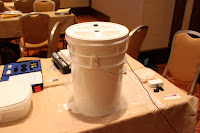 |
| tub for re-calibrating silica gel |
 |
| data logger |
The workshop I attended was "Understanding Microclimates," led by Fenella France and Rachael Perkins Arenstein. While all of the tours and many other workshop sessions sounded interesting, I chose this particular one because I have yet to have formal instruction concerning microclimates. From my previous experience in many different labs and from my chemistry courses, I felt like I had a basic understanding of what microclimates are and how they impact artwork, but I recognized that they apply to absolutely everything I might work with in conservation. From storage to exhibition, all objects are affected by their immediate microclimate, and while museums have standards for their relative humidity, temperature, and lights, certain objects require further restrictions. What I really took away from the workshop were methods of controlling and treating unwanted conditions, whether it be high relative humidity or a leak in the display case or even light from an open atrium. We also discussed many different data loggers (who knew there were so many, and so many neat ways to use them) and received a goody bag full of silica gel, display case building materials, humidity test strips, and other fun little tools.
 |
| goodie bag! |
 |
| handy preventative treatment brochures! |
The opening reception was at the Philadelphia Museum of Art, and they were kind enough to open some of the galleries for us. We were lucky enough to be there for the final days of the Roberto Capucci exhibit, which was spectacular. Honestly, his control and understanding of fabric is astounding. They had some great Duchamp pieces (the famed
Nude Descending a Staircase and his
Bride) as well as countless other gorgeous sculptures and, all time crowd-pleaser, a small Art Nouveau collection. I also was entertained to find some brochures on preserving one's own collection, from paintings to frames to textiles - handy little tips for where to display them in a house and what materials to mount them on.
(Please excuse the formatting for the photos. Also, they'll increase to full size if clicked)
 |
goltzius, without cares and bacchus,
venus would freeze |
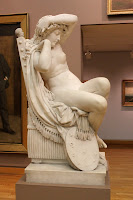 |
| roberts, la premiere pose |
 |
| degas, little dancer |
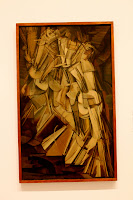 |
duchamp, nude
descending a staircase |
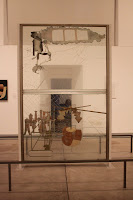 |
duchamp, the bride stripped bare
by her bachelors, even |
 |
| piamontini, jupiter |
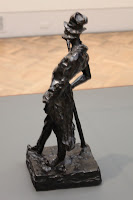 |
| daumier, ratapoil |
 |
| unknown, spring and summer |
 |
| frederic, the four seasons |
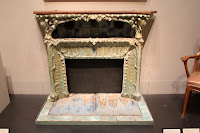 |
| guimard, fireplace |
 |
| rosseau, carnival evening |
 |
| rodin, bellona |